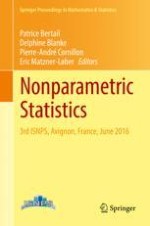This volume presents the latest advances and trends in nonparametric statistics, and gathers selected and peer-reviewed contributions from the 3rd Conference of the International Society for Nonparametric Statistics (ISNPS), held in Avignon, France on June 11-16, 2016. It covers a broad range of nonparametric statistical methods, from density estimation, survey sampling, resampling methods, kernel methods and extreme values, to statistical learning and classification, both in the standard i.i.d. case and for dependent data, including big data.
The International Society for Nonparametric Statistics is uniquely global, and its international conferences are intended to foster the exchange of ideas and the latest advances among researchers from around the world, in cooperation with established statistical societies such as the Institute of Mathematical Statistics, the Bernoulli Society and the International Statistical Institute. The 3rd ISNPS conference in Avignon attracted more than 400 researchers from around the globe, and contributed to the further development and dissemination of nonparametric statistics knowledge.
